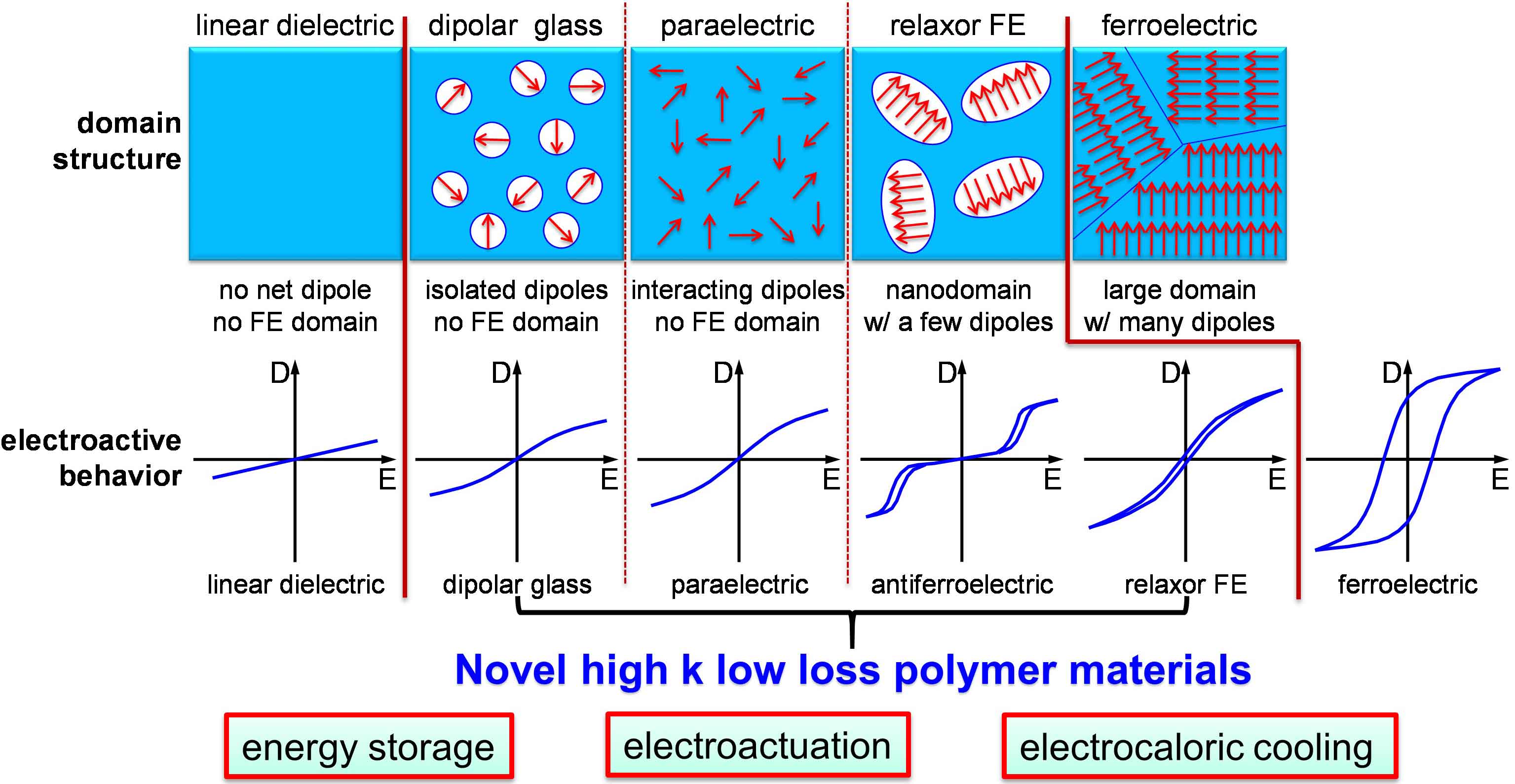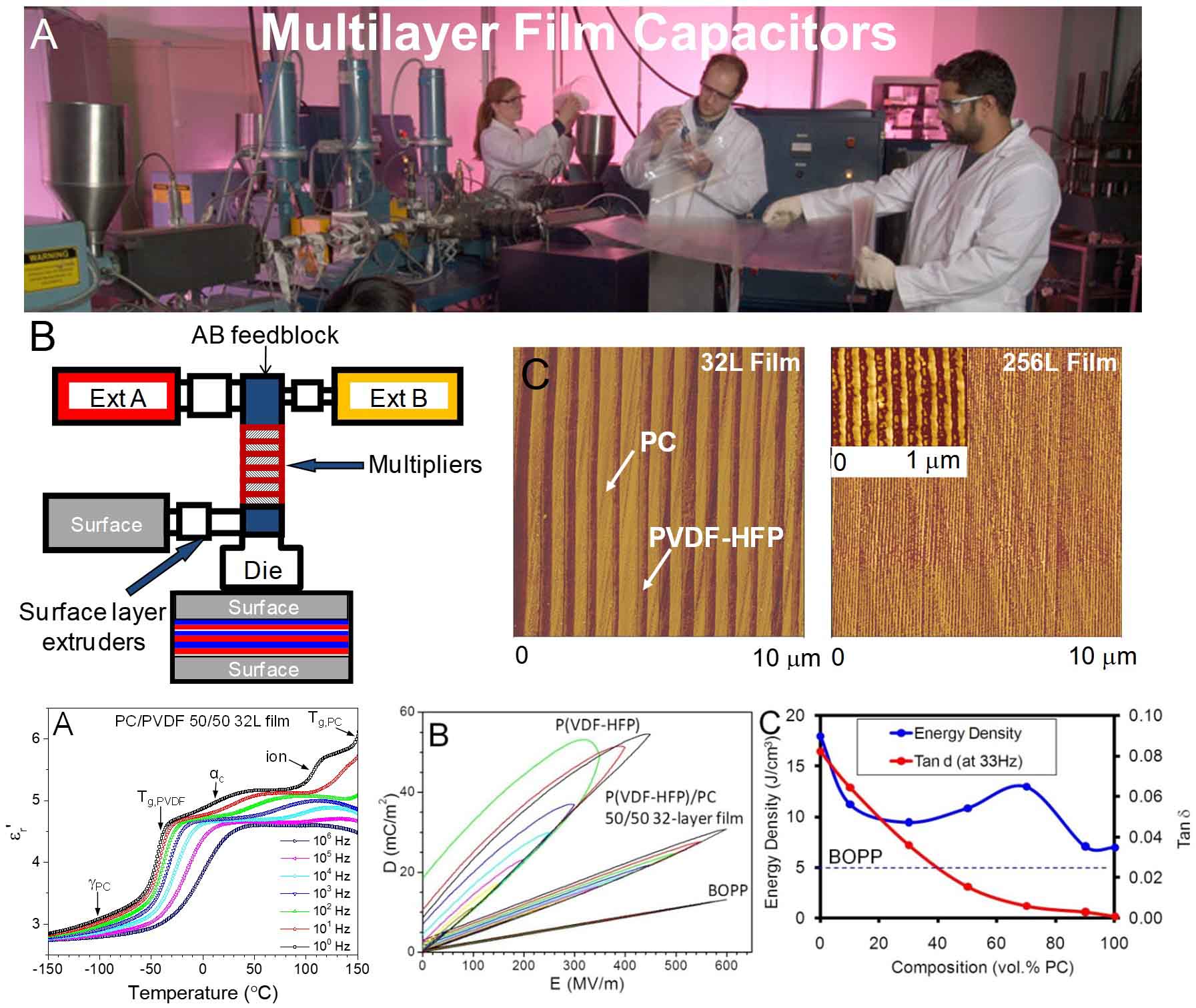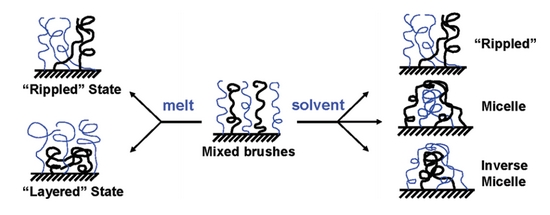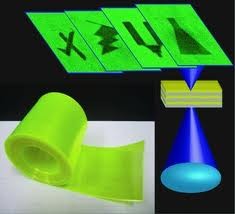Research
1. High K, Low Loss Polymers for Electrical Appications
I) Novel High Dielectric Constant and Low Loss Polymer Dielectrics

Polymer dielectrics having high dielectric constant, high temperature capability, and low loss are attractive for a broad range of applications such as film capacitors, gate dielectrics, artificial muscles, and electrocaloric cooling. Unfortunately, it is generally observed that higher polarization or dielectric constant tends to cause significantly enhanced dielectric loss. It is therefore highly desired that the fundamental physics of all types of polarization and loss mechanisms be thoroughly understood for dielectric polymers. In this Perspective, we intend to explore advantages and disadvantages for different types of polarization.Among a number of approaches, dipolar polarization is promising for high dielectric constant and low loss polymer dielectrics, if the dipolar relaxation peak can be pushed to above the gigahertz range. In particular, dipolar glass, paraelectric, and relaxor ferroelectric polymers are discussed for the dipolar polarization approach.
Representation Publications:
1. Zhu, L.*; Wang, Q.* Novel ferroelectric polymers for high energy density and low loss dielectrics. Macromolecules 2012, 45, 2937–2954.
2. Yang, L.; Li, X,; Allahyarov, E.; Taylor, P. L.; Zhang, Q. M.*; Zhu, L.* Novel polymer ferroelectric behavior via crystal isomorphism and the nanoconfinement effect. Polymer 2013, 54, 1709-1728.
3. Zhu, L.* Exploring strategies for high dielectric constant and low loss polymer dielectrics. J. Phys. Chem. Lett. 2014, 5, 3677-3687.
II) Multilayer Film System

Using multilayer coextrusion (above figure), a high dielectric constant polymer (e.g. PVDF) can be multilayered with a highly insulating dielectric polymer (e.g. PC, PET and PSF). The dielectric properties of PVDF-based multilayer films depended on both PVDF and the dielectric layers and the interaction between them. First, dipole switching in PVDF is prohibited by non-uniform electric field distributions. Second, decreasing the PVDF layer thickness effectively reduces the impurity migrational loss. Third, interfacial polarization in the PVDF layer enhances the breakdown strength for multilayer films. Fourth, internal electron tunneling can be effectively blocked by relatively thick dielectric polymer layer. Finally, high temperature DC conduction should be minimized by using a high Tg and low conduction dielectric layer.
Representation Publications:
1. Baer, E.; Zhu, L.*, Dielectric phenomena in polymers and multilayered dielectric films. Macromolecules 2017, 50, 2239-2256.
III) Nanodielectrics
It is known that certain ceramics exhibit high dielectric constant in the order of thousands. Nartually, it is desired to blend ceramic nanoparticles into polymers to achieve high dielectric constant nanocomposites with a wish that the dielectric breakdonw strength will not substantially decrease. Nanocomposites are preferred than micro-composites because local electric field enhancement in the low dielectric constant polymer matrix between neighboring ceramic particles can be largely reduced to ensure relatively high norminal breakdown strength. Currently, we are working to achieve uniform particle dispersion, reduce internal electron conduction, and reduce the ceramic content to facilitate better processing.
Representation Publications:
1. Zhang, G.; Brannum, D.; Dong, D.; Tang, L.; Allahyarov, E.; Tang, S.; Kodweis, K.; Lee, J.-K.; Zhu, L.* Interfacial polarization-induced loss mechanisms in polypropylene/BaTiO3 nanocomposite dielectrics. Chem. Mater. 2016, 28, 4646-4660.
2. Zhang, G.; Li, Y.; Tang, S.; Thompson, R. D.; Zhu, L.*, The role of field electron emission in polypropylene/aluminum nanodielectrics under high electric fields. ACS Appl. Mater. Interfaces, 2017, 9, 10106-10119.
2. Electroactive Polymers
Electrically active polymers are a unique class of materials, where the polymer will contract or bend, in proportion to an applied electric voltage. The stress and strain characteristics of natural muscle are best approximated by dielectric elastomers. Furthermore, the capacity for eneryg generation per kilogram in dielectric elastomers, across all frequencies, exceeds that of native muscle. Hence, dielectric elastomers appear to be the most promising class for artificial muscles. We are interested in high dielectric constant and low leakage current elastomers for this application.
Representation Publications:
1. Liu, L.; Huang, Y.; Allahyarov, E.*; Zhang, Z.; Lv, F.; Zhang, Y.*; Zhu, L.* Understanding reversible Maxwellian electroactuation in a 3M VHB dielectric elastomer with prestrain. Polymer 2018, 144, 150-158.
3. Mixed Brushes

Mixed polymer brush-grafted particles, in which two distinct polymers are randomly or alternately immobilized by one end via a covalent bond on the surface of core particles with sufficiently high grafting densities, represent a new, intriguing class of environmentally responsive nanostructured hybride materials. The two end-tethered polymers can undergo spontaneous chain reorganization in response to environmental variations, rendering particles adaptive surface properties and different colloidal behavior. Currently, we are interested in the morphology study of the mixed polymer brush-grafted silicon particles.
Representation Publications:
1. Zhao, B.*; Zhu, L. Mixed polymer brush-grafted particles: A new class of environmentally responsive nanostructured materials. Macromolecules 2009,42, 9369-9383.
4. Optical Data Storage

This research project is to take advantages of both nanotechnology and multilayered coextrusion processing to advance the development of next-generation optical data storage plastics. Our basic idea is built upon the so-called metal nanoparticle enhanced fluorescence phenomenon. The research involves dye-containing polymers synthesized by reversible addition-fragmentation chain-transfer polymerization (RAFT) and core-shell silver nanoparticle stablized by the dye-containing polymer. Inclusion of these functional core-shell silver nanoparticles in the maltilayer structure will enable 3D writing and reading processes for optical data storage.
Our research is supported by:

  
|